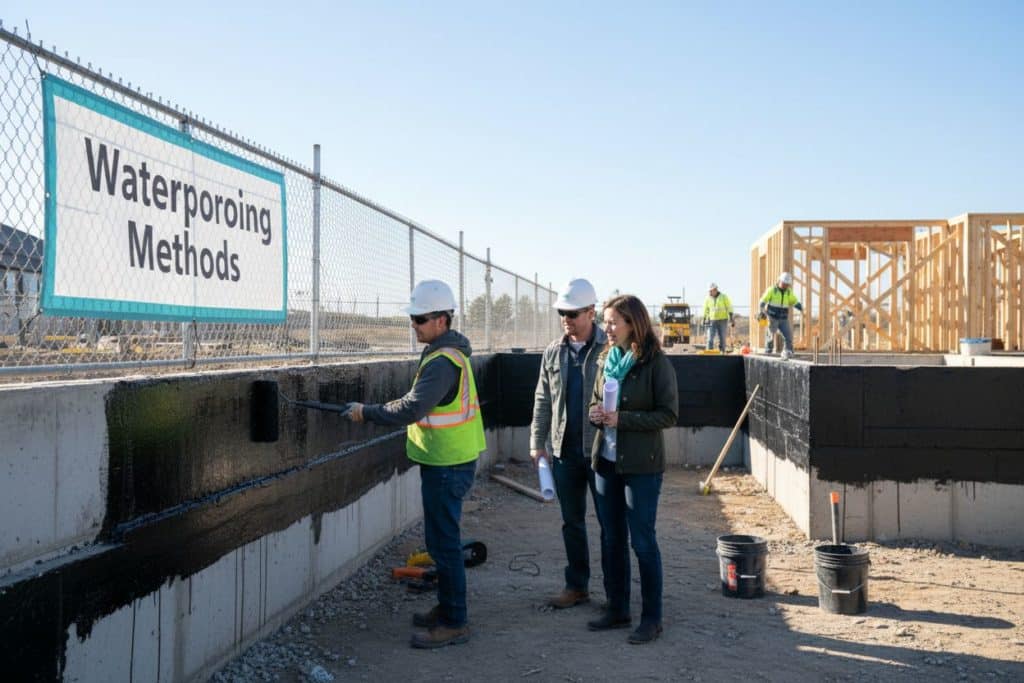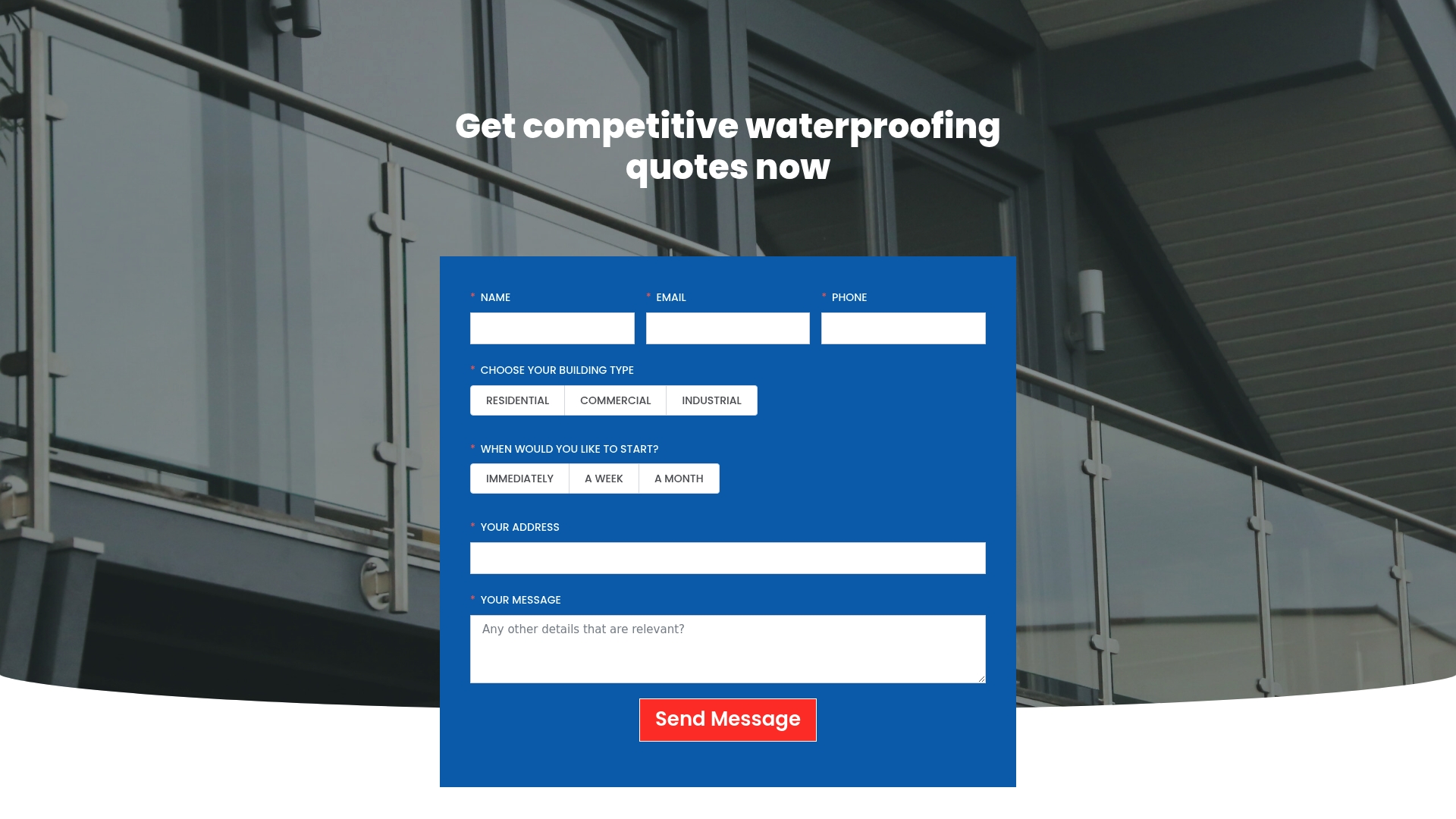Waterproofing is often overlooked until disaster strikes, yet the real risks from water damage are far more severe than most property owners realise. Did you know that water-related damages can cost homeowners thousands of pounds in repairs. The most surprising part is that a well-chosen waterproofing method can turn those risks into long-term financial savings and improved health for everyone under your roof.
Table of Contents
- What Are Waterproofing Methods And Their Importance?
- Why Waterproofing Matters For Property Owners
- How Different Waterproofing Methods Work
- Key Concepts Behind Effective Waterproofing Techniques
- Common Applications Of Waterproofing In Real Estate
Quick Summary
| Takeaway | Explanation |
|---|---|
| Waterproofing prevents costly structural damage | Effective waterproofing can significantly reduce long-term repair expenses by blocking water intrusion. |
| Professional waterproofing is a strategic investment | Investing in waterproofing solutions maintains property value and longevity, safeguarding financial interests. |
| Moisture intrusion leads to health hazards | Preventing water penetration helps avoid mould and mildew that can harm occupants’ health. |
| Targeted methods fit specific structural needs | Different properties require tailored waterproofing approaches for effective moisture management. |
| Critical areas need specific protection | Foundations, basements, and roofs are particularly susceptible to moisture, requiring thorough waterproofing strategies. |
What are Waterproofing Methods and Their Importance?
Waterproofing represents a critical protective strategy designed to prevent moisture penetration and damage in buildings, infrastructure, and various constructed environments. At its core, waterproofing involves applying specialised techniques and materials that create a robust barrier against water intrusion, protecting structural integrity and preventing potential long-term damage.
Understanding Water Intrusion Risks
Water represents one of the most destructive elements in construction. When moisture penetrates building structures, it can cause extensive and costly damage. Our comprehensive guide on waterproofing highlights the significant risks associated with water infiltration:
- Structural deterioration
- Mould and fungal growth
- Compromised building foundation
- Electrical system damage
- Reduced property value
Key Components of Effective Waterproofing
Effective waterproofing encompasses multiple strategic approaches tailored to specific environmental conditions and structural requirements. Professional waterproofing methods typically involve comprehensive assessments that identify potential moisture entry points and implement targeted solutions. These solutions range from surface treatments and sealants to complex drainage systems that redirect water away from critical structural elements.
The importance of waterproofing extends beyond immediate protection. By preventing moisture penetration, property owners can significantly reduce maintenance costs, preserve building aesthetics, and maintain healthy living or working environments. Professional waterproofing interventions serve as a critical investment in long-term property preservation, offering protection against environmental challenges and potential structural degradation.
Why Waterproofing Matters for Property Owners
For property owners, waterproofing represents far more than a routine maintenance task. It is a strategic investment that protects financial value, ensures structural longevity, and safeguards the health and comfort of occupants. Our comprehensive roof waterproofing guide explores the multifaceted benefits of professional waterproofing solutions.
Financial Protection and Property Value
Waterproofing directly impacts property economics by preventing expensive structural damage. Water infiltration can lead to significant repair costs that far exceed preventative investment.
IMAGE:descriptive_key_1] According to the [National Association of Home Builders, water-related damages can cost homeowners thousands of pounds in repairs, making proactive waterproofing a critical financial strategy.
Key financial advantages of waterproofing include:
- Preventing costly structural repairs
- Maintaining property market value
- Reducing long-term maintenance expenses
- Lowering insurance claim risks
Health and Structural Integrity
Beyond financial considerations, waterproofing plays a crucial role in maintaining a healthy living environment. Moisture intrusion creates ideal conditions for mould, mildew, and fungal growth, which can cause significant respiratory health problems. Proper waterproofing acts as a protective shield, preventing these harmful organisms from developing and spreading throughout a property.
Structurally, water penetration can compromise building foundations, weaken load-bearing walls, and accelerate material degradation. By implementing comprehensive waterproofing strategies, property owners protect their investment against progressive structural damage, ensuring buildings remain safe, stable, and resilient against environmental challenges.
How Different Waterproofing Methods Work
Waterproofing encompasses diverse techniques designed to address specific moisture challenges across different structural environments. Our detailed guide on exterior basement waterproofing techniques highlights the complexity and nuanced approach required for effective water protection.
Surface Application Waterproofing Methods
Surface waterproofing involves applying specialised protective layers directly onto building structures to prevent water penetration. These methods typically include liquid-applied membranes, cementitious coatings, and penetrative sealants that create an impermeable barrier against moisture intrusion.
Key surface waterproofing techniques include:
- Elastomeric coating applications
- Acrylic-based liquid membranes
- Polyurethane sealant treatments
- Bituminous membrane installations
Structural Drainage and Water Redirection
Beyond surface protection, advanced waterproofing strategies focus on comprehensive water management. According to the International Building Code, effective water management requires sophisticated drainage systems that actively redirect moisture away from critical structural elements. These methods involve creating strategic water channels, installing French drains, and implementing subsurface drainage solutions that prevent water accumulation near foundational areas.
The table below compares two main waterproofing approaches and summarises their core features, helping readers quickly distinguish between surface application methods and structural drainage techniques.
| Waterproofing Approach | Description | Typical Methods | Main Advantages |
|---|---|---|---|
| Surface Application | Protects surfaces by applying impermeable coatings or sealants | Liquid-applied membranes, elastomeric coatings, cementitious coatings, bituminous systems | Easy to apply, versatile for various surfaces |
| Structural Drainage & Redirection | Redirects water away from structures using embedded drainage systems | French drains, subsurface drainage solutions, water channels | Actively manages water, ideal for foundations |
Drainage-based waterproofing approaches integrate multiple techniques to ensure comprehensive moisture control. These methods not only block water entry but also create active mechanisms for water redirection, significantly reducing potential structural damage risks. By understanding the intricate relationship between water movement and structural integrity, property owners can implement targeted interventions that provide long-lasting protection against moisture-related deterioration.
Key Concepts Behind Effective Waterproofing Techniques
Waterproofing demands a sophisticated understanding of moisture dynamics, material science, and structural engineering principles. Our comprehensive blog resources explore the intricate approaches professionals use to protect buildings from water damage.
Material Compatibility and Performance
Successful waterproofing relies on selecting appropriate materials that interact harmoniously with specific structural environments. Different building materials react uniquely to moisture exposure, requiring tailored waterproofing solutions that account for substrate composition, environmental conditions, and potential stress factors.
Key material considerations include:
- Thermal expansion characteristics
- Chemical resistance
- Flexibility and elongation properties
- Surface adhesion capabilities
- Long-term durability under moisture stress
Moisture Barrier Principles
According to the New Zealand Building Code Guidelines, effective moisture barriers must incorporate multiple protective strategies. Redundancy becomes crucial in waterproofing design, meaning multiple layers of protection are implemented to ensure comprehensive water resistance.
Professional waterproofing techniques focus on creating comprehensive moisture management systems that do more than simply blocking water. These advanced approaches involve understanding water movement, pressure differentials, and potential infiltration points, allowing for proactive and predictive protection strategies that go beyond traditional surface-level treatments.
Common Applications of Waterproofing in Real Estate
Our comprehensive waterproofing application guide highlights the critical role of targeted waterproofing strategies across various property types. Waterproofing extends far beyond simple surface treatments, representing a comprehensive approach to protecting structural integrity and maintaining property value.
Critical Property Areas Requiring Waterproofing
Certain architectural elements are inherently more vulnerable to moisture penetration and require specialised waterproofing interventions. These strategic locations demand precise, multi-layered protection to prevent long-term structural degradation.
Key areas requiring comprehensive waterproofing include:
- Building foundations
- Basement and underground spaces
- Exterior wall surfaces
- Roof and terrace structures
- Bathrooms and wet areas
- Balconies and external decking
Residential and Commercial Waterproofing Contexts
According to the US Department of Energy Building Technologies Office, waterproofing applications vary significantly between residential and commercial properties. Different structural designs and usage patterns necessitate tailored moisture management approaches. Commercial buildings often require more complex drainage systems and industrial-grade protective membranes, while residential properties might focus on targeted interventions that balance aesthetic considerations with functional protection.
Understanding the nuanced requirements of different property types allows property owners and managers to implement precise, cost-effective waterproofing strategies that provide long-term protection against moisture-related damage and structural deterioration.
This table provides an at-a-glance summary of the key areas in typical properties that most frequently require waterproofing interventions, supporting readers in identifying high-priority sites for protection.
| Area of Property | Why Vulnerable to Moisture | Common Problems Prevented |
|---|---|---|
| Foundations | Constant soil moisture exposure | Structural weakening, cracking |
| Basements and Underground | Below ground, prone to seepage | Dampness, mould, flooding |
| Exterior Walls | Direct weather and rain exposure | Peeling paint, damp patches |
| Roofs and Terraces | Exposed to rainwater and standing water | Leaks, rot, internal damp spots |
| Bathrooms and Wet Areas | Frequent water use and humidity | Mould, tile and fixture breakdown |
| Balconies and Decks | Open to the elements, poor runoff | Surface deterioration, leaks |
Take Control of Moisture and Protect What Matters Most
After reading about waterproofing methods in simple terms, you now see how moisture can quietly destroy both comfort and investment in your property. Issues like mould, weakened foundations and unexpected repair costs create both stress and financial loss. The article highlights why taking preventative action and understanding modern waterproofing solutions is essential to keep your home or business safe.
Learn how local professionals apply these techniques and discover the peace of mind that comes from expert protection. See for yourself:
Do not wait until water intrusion becomes irreversible. Connect with Pro Waterproofing today and get personalised advice, a no-obligation quote and access to reliable solutions that last. Secure your property before the next rainy season and benefit from proven expertise trusted in South Africa.
Frequently Asked Questions
What are the main methods of waterproofing?
There are various waterproofing methods, including surface application techniques like liquid-applied membranes, elastomeric coatings, and cementitious coatings. Additionally, structural drainage practices, such as installing French drains and subsurface drainage systems, help redirect water away from critical areas.
Why is waterproofing important for my property?
Waterproofing is essential as it prevents moisture intrusion that can lead to structural deterioration, mould growth, and reduced property value. It also safeguards the health of occupants by creating a healthier living environment, free from moisture-related issues.
How can I identify areas in my property that need waterproofing?
Key areas to inspect include building foundations, basements, exterior walls, roofs, bathrooms, and balconies. Look for signs of moisture damage, such as mould, peeling paint, or damp spots, which indicate that waterproofing may be necessary.
What factors should I consider when choosing waterproofing materials?
When selecting waterproofing materials, consider aspects like thermal expansion properties, chemical resistance, flexibility, and long-term durability. It’s crucial to choose materials compatible with the specific environmental conditions and building materials of your property.


